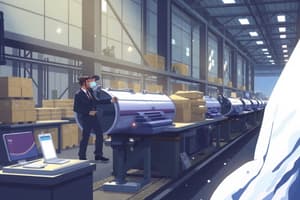Podcast
Questions and Answers
What type of materials includes raw materials and components used during production?
What type of materials includes raw materials and components used during production?
- Office supplies
- Finished goods
- Waste materials
- Purchased materials (correct)
Chemical properties can be observed without changing the material's composition.
Chemical properties can be observed without changing the material's composition.
False (B)
What is considered a final product in a cotton mill?
What is considered a final product in a cotton mill?
yarn or cloth sheets
Materials' physical properties include color, hardness, and __________.
Materials' physical properties include color, hardness, and __________.
Match the following types of materials with their descriptions:
Match the following types of materials with their descriptions:
Which of the following is considered a material resource?
Which of the following is considered a material resource?
Composites are materials constructed from two or more combined materials.
Composites are materials constructed from two or more combined materials.
The cost associated with managing materials includes purchasing costs and __________.
The cost associated with managing materials includes purchasing costs and __________.
What is the main goal of standardization in materials management?
What is the main goal of standardization in materials management?
Simplification in materials management aims to increase the variety of products manufactured.
Simplification in materials management aims to increase the variety of products manufactured.
What are the famous 5 Rs of Materials Management?
What are the famous 5 Rs of Materials Management?
Forecasting is the technique of estimating future events based on __________.
Forecasting is the technique of estimating future events based on __________.
Match the following concepts with their descriptions:
Match the following concepts with their descriptions:
Which of the following is NOT one of the 5 Rs of Materials Management?
Which of the following is NOT one of the 5 Rs of Materials Management?
Ergonomics is concerned with the man-machine system in materials management.
Ergonomics is concerned with the man-machine system in materials management.
What is the purpose of forecasting according to Webster's new Collegiate Dictionary?
What is the purpose of forecasting according to Webster's new Collegiate Dictionary?
What is the primary role of planning in an organization?
What is the primary role of planning in an organization?
Planning can be effectively done without forecasting.
Planning can be effectively done without forecasting.
What is the first step in the forecasting process?
What is the first step in the forecasting process?
Forecasting is concerned with __________ events.
Forecasting is concerned with __________ events.
Which of the following is a qualitative method of forecasting?
Which of the following is a qualitative method of forecasting?
Match the following forecasting methods with their descriptions:
Match the following forecasting methods with their descriptions:
Which step involves comparing actual results with estimated results?
Which step involves comparing actual results with estimated results?
Effective control can be executed based on inadequate information from forecasting.
Effective control can be executed based on inadequate information from forecasting.
Which variable represents the smoothing constant in the exponential smoothing method?
Which variable represents the smoothing constant in the exponential smoothing method?
The seasonal index is always greater than 1 during peak seasons.
The seasonal index is always greater than 1 during peak seasons.
What is the formula for calculating the new forecast using the exponential smoothing method?
What is the formula for calculating the new forecast using the exponential smoothing method?
The average monthly demand for swimsuits is 100 units, and in July it is 175. The seasonal index for July is __________.
The average monthly demand for swimsuits is 100 units, and in July it is 175. The seasonal index for July is __________.
Match the following months with their seasonal indices based on the demand examples given.
Match the following months with their seasonal indices based on the demand examples given.
Using the exponential smoothing method, if the last period’s actual demand was 190 and the last forecasted demand was 220, with α=0.15, what is the forecast for the next period?
Using the exponential smoothing method, if the last period’s actual demand was 190 and the last forecasted demand was 220, with α=0.15, what is the forecast for the next period?
The total of all seasonal indices equals the length of the season.
The total of all seasonal indices equals the length of the season.
What does deseasonalized demand refer to?
What does deseasonalized demand refer to?
What is the purpose of deseasonalizing demand?
What is the purpose of deseasonalizing demand?
The seasonal index for a month is used to increase the average demand for that month.
The seasonal index for a month is used to increase the average demand for that month.
What is the formula to calculate deseasonalized demand?
What is the formula to calculate deseasonalized demand?
In forecasting, the forecast for _______ demand is calculated from the average demand using the appropriate season index.
In forecasting, the forecast for _______ demand is calculated from the average demand using the appropriate season index.
If the seasonal index for July is 2.5 and the actual demand is 24,000 units, what is the deseasonalized demand?
If the seasonal index for July is 2.5 and the actual demand is 24,000 units, what is the deseasonalized demand?
Exponential smoothing requires previous forecasts to calculate future values.
Exponential smoothing requires previous forecasts to calculate future values.
In associative forecasting, what statistical method is commonly used to relate variables?
In associative forecasting, what statistical method is commonly used to relate variables?
In the regression equation Y = a + bX, what does Y represent?
In the regression equation Y = a + bX, what does Y represent?
Bias in forecasting means that actual demand consistently varies from forecast demand in an irregular manner.
Bias in forecasting means that actual demand consistently varies from forecast demand in an irregular manner.
What does the acronym MAD stand for in the context of measuring forecast error?
What does the acronym MAD stand for in the context of measuring forecast error?
The difference between actual demand and forecast demand is known as the ______.
The difference between actual demand and forecast demand is known as the ______.
Match the following terms with their definitions:
Match the following terms with their definitions:
What is one characteristic of systematic error in forecasting?
What is one characteristic of systematic error in forecasting?
Tracking the forecast helps in planning around forecast errors.
Tracking the forecast helps in planning around forecast errors.
What would indicate that a forecast should be evaluated or changed?
What would indicate that a forecast should be evaluated or changed?
Flashcards
Purchased Materials
Purchased Materials
The raw materials, components, spare parts, and other supplies that a company buys from external suppliers.
Work in Process (WIP) Materials
Work in Process (WIP) Materials
The materials that are in the process of being transformed into finished goods, like partially assembled products on the production line.
Finished Goods
Finished Goods
The final products that a company produces and is ready to sell to customers.
Basic Price
Basic Price
Signup and view all the flashcards
Purchasing Costs
Purchasing Costs
Signup and view all the flashcards
Inventory Carrying Cost
Inventory Carrying Cost
Signup and view all the flashcards
Transportation Cost
Transportation Cost
Signup and view all the flashcards
Materials Handling Cost
Materials Handling Cost
Signup and view all the flashcards
5 Rs of Materials Management
5 Rs of Materials Management
Signup and view all the flashcards
Simplification (Materials Management)
Simplification (Materials Management)
Signup and view all the flashcards
Ergonomics (Human Engineering)
Ergonomics (Human Engineering)
Signup and view all the flashcards
Forecasting
Forecasting
Signup and view all the flashcards
Specifications (Materials Management)
Specifications (Materials Management)
Signup and view all the flashcards
Value Analysis
Value Analysis
Signup and view all the flashcards
Standardization (Materials Management)
Standardization (Materials Management)
Signup and view all the flashcards
Standardization (Definition)
Standardization (Definition)
Signup and view all the flashcards
Exponential Smoothing Method
Exponential Smoothing Method
Signup and view all the flashcards
Alpha (α)
Alpha (α)
Signup and view all the flashcards
Deseasonalized Demand
Deseasonalized Demand
Signup and view all the flashcards
Seasonal Index
Seasonal Index
Signup and view all the flashcards
Period Average Demand
Period Average Demand
Signup and view all the flashcards
Average Demand for all Periods
Average Demand for all Periods
Signup and view all the flashcards
Seasonal Forecast
Seasonal Forecast
Signup and view all the flashcards
Forecasts (Limitations)
Forecasts (Limitations)
Signup and view all the flashcards
Planning's Role in an Organization
Planning's Role in an Organization
Signup and view all the flashcards
What is Forecasting?
What is Forecasting?
Signup and view all the flashcards
Relationship between Planning and Forecasting
Relationship between Planning and Forecasting
Signup and view all the flashcards
Purpose of Business Establishment
Purpose of Business Establishment
Signup and view all the flashcards
Forecasting's Role in Project Implementation
Forecasting's Role in Project Implementation
Signup and view all the flashcards
Forecasting's Impact on Coordination
Forecasting's Impact on Coordination
Signup and view all the flashcards
Forecasting's Contribution to Control
Forecasting's Contribution to Control
Signup and view all the flashcards
Features of Good Forecasting
Features of Good Forecasting
Signup and view all the flashcards
What is Deseasonalized Demand?
What is Deseasonalized Demand?
Signup and view all the flashcards
What is Associative Forecasting?
What is Associative Forecasting?
Signup and view all the flashcards
What is Linear Regression in Forecasting?
What is Linear Regression in Forecasting?
Signup and view all the flashcards
What is Average Demand?
What is Average Demand?
Signup and view all the flashcards
What is Seasonal Index?
What is Seasonal Index?
Signup and view all the flashcards
What is Deseasonalized Demand?
What is Deseasonalized Demand?
Signup and view all the flashcards
What is Forecasting with Seasonality?
What is Forecasting with Seasonality?
Signup and view all the flashcards
What is Exponential Smoothing?
What is Exponential Smoothing?
Signup and view all the flashcards
Dependent and Independent Variables in Regression
Dependent and Independent Variables in Regression
Signup and view all the flashcards
Regression Equation
Regression Equation
Signup and view all the flashcards
Tracking Forecast
Tracking Forecast
Signup and view all the flashcards
Forecast Error
Forecast Error
Signup and view all the flashcards
Forecast Bias
Forecast Bias
Signup and view all the flashcards
Random Variation in Forecast
Random Variation in Forecast
Signup and view all the flashcards
Mean Absolute Deviation (MAD)
Mean Absolute Deviation (MAD)
Signup and view all the flashcards
Evaluating Forecast Accuracy
Evaluating Forecast Accuracy
Signup and view all the flashcards
Study Notes
Materials Management
- Materials management encompasses the planning, organizing, and control of material flow from initial purchase to distribution points.
- It includes raw materials, components, spare parts, oils, grease, cotton, waste, consumables, and tools among other items.
- Work in progress (WIP) materials comprise semi-finished and finished components in the shop floor.
- Finished goods are the final products, held in stock pending delivery or sale. Costs associated with finished goods include basic price, purchasing, inventory carrying, transportation, handling, office, packing, marketing, obsolescence, and wastage.
6Ms in Operations Management
- The 6Ms of production include: Measurement, Milieu, Material, Manpower, Method, and Machine.
Definition of Materials
- Materials are the matter or substance objects are made from.
- Materials can be raw or semi-finished items used to create a final product.
- Examples include cotton in a cotton mill, which is transformed into yarn or cloth, then to clothing.
- Raw materials in one factory can be the raw material for another.
Material Resources
- Material resources are sourced from the natural world,
- Useful for humans. This includes wood, glass (from sand), metals, edible plants, and plastics (from natural chemicals).
Physical vs Chemical Properties
- Physical properties are observed or measured without altering the material. Examples include color, hardness, smell, freezing, melting, and boiling points.
- Chemical properties are determined through observing chemical reactions. Examples include combustion point, reactivity to acids, and toxicity.
Scope of Materials Management
- This area of study has four elements: Material planning and control, Purchasing, Stores management, and Inventory management.
- Additional functions include standardization, simplification, specifications, value analysis, ergonomics, and just-in-time
Forecasting Techniques
- Forecasting is the systematic guessing of future events utilizing past and present data. It's fundamental to planning.
- It analyzes past and current conditions.
- Forecasts do not consider random variation, are made for average demand, and seasonal demand is calculated using the average demand and a seasonal index.
- Qualitative forecasting methods are subjective, based on judgment/intuition, whereas quantitative methods utilize past patterns or data.
Types of Forecasting
- Qualitative methods include expert opinion and the Delphi Method.
- Quantitative methods include time-series models (historical data) and associative models (casual variables). Time series methods include naïve, simple/moving averages, weighted moving averages, and exponential smoothing.
Time Series Models
- Naïve method simply repeats the previous period's value.
- Simple mean (average) uses the average of all past data
- Simple moving average uses the average of a specified number of past periods; each is weighted equally
- Weighted moving average uses the average of a specified number of past periods; periods are weighted differently.
- Exponential smoothing uses a weighted average with weights declining exponentially over time.
- Trend projection identifies patterns and trends in data to forecast future values.
- Seasonal indices help to adjust forecasts for seasonal patterns and variations.
Measuring Forecast Accuracy
- Tracking the forecast involves comparing actual demand with the forecast.
- Forecast error is the difference between actual and forecasted demand.
- Bias occurs when forecasts consistently overestimate or underestimate demand.
- Random fluctuations occur when no pattern is evident in past demand.
- Mean Absolute Deviation (MAD) measures the average forecast error; this involves summing the absolute forecast errors and dividing by the number of forecast periods.
- These errors and biases can be used for contingency planning and setting safety stock levels.
Objectives of Materials Management
- This focuses on acquiring materials and services which are of the right quality, right quantity, at the right time, right source, and right price.
Studying That Suits You
Use AI to generate personalized quizzes and flashcards to suit your learning preferences.




